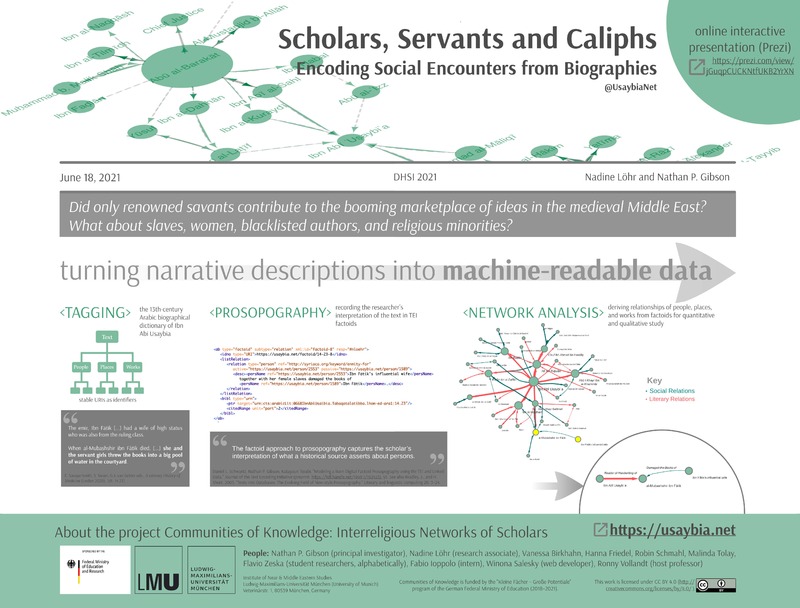Scholars, Servants and Caliphs: Encoding Social Encounters from Biographies
Item
-
Title
-
Scholars, Servants and Caliphs: Encoding Social Encounters from Biographies
-
Description
-
A poster presented at the DHSI 2021 – Online Edition Conference & Colloquium
-
Creator
-
Nadine Löhr
-
Nathan P. Gibson
-
Date
-
2021
-
Format
-
JPG, docx
-
Rights Holder
-
Nadine Löhr, Nathan P. Gibson
-
Language
-
English
-
Abstract
-
Who contributed to the booming marketplace of ideas in the medieval Middle East? Was it only renowned savants? Or was there also a role for slaves, women, blacklisted authors, and religious minorities?
Bio-bibliographical reference works are an indispensable source for answering questions like these. The potential they bear goes far beyond a historian’s search for entries about a single person, since they allow us to link identified places and individuals, encode their interactions, and analyze networks of scholarly exchange. In the "Communities of Knowledge" project, we examine how pioneering Middle Eastern scholars in fields such as medicine, mathematics, and philosophy interacted socially across the bounds of their Jewish, Christian, and Muslim communities. To do this, we analyze hundreds of biographies spanning five centuries (750–1258), composed and compiled by Ibn Abī Uṣaybiʿa (d. 1270), a Muslim doctor from Syria. In his history of medicine, he describes with rich social detail the interactions of these physicians and other scholars and provides the titles of nearly 4,000 works, many of them now lost.
Capturing these detailed interactions in a network graph allows us to read the text against the grain, seeing the role not only of the "great scholars" highlighted by Ibn Abī Uṣaybiʿa or later scholarship but also of women, slaves, patrons, and authors whose work did not survive. But network analysis requires that we derive structured, machine-readable data from these narrative, biographical descriptions. Following the lead of pioneers in prosopography, we encode researchers' interpretations of the primary source text as "factoids," structured pieces of data. These factoids become network edges showing relationships between authority-controlled entities (persons, places, and works). This enables our network analysis to closely link documented inferences to both the network graph and the source text, as well as (through linked-open data) to related information in collaborating projects.
It is our hope that this factoids-to-network approach will stimulate discussion about sound procedures for analyzing networks in biographical texts and can be a steppingstone for other projects working with historical sources in a wide variety of disciplines.
-
Type
-
Poster



